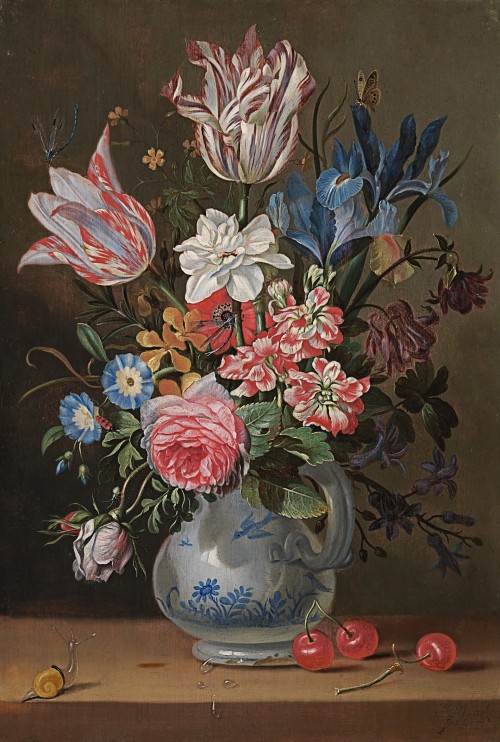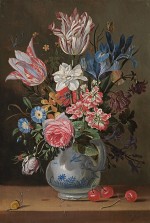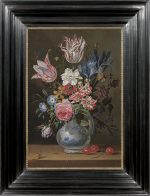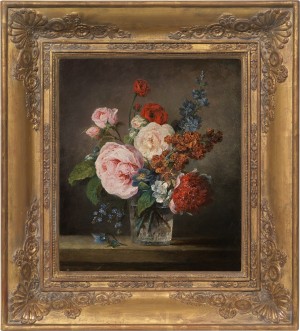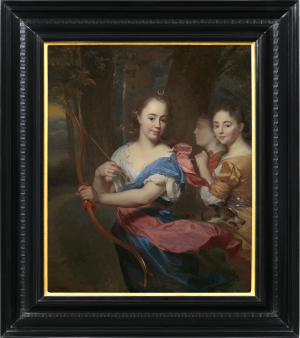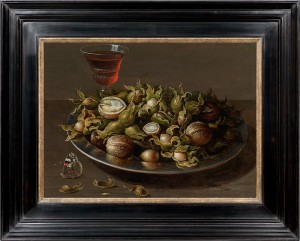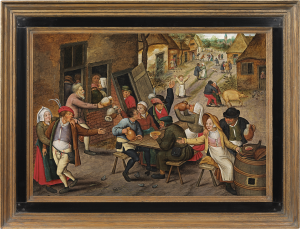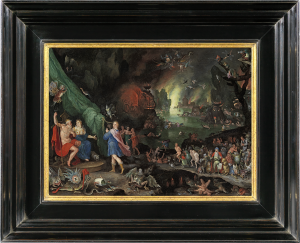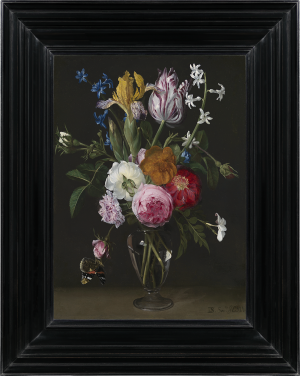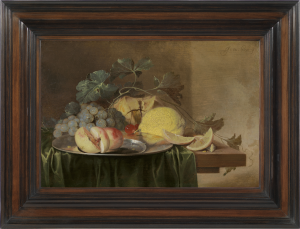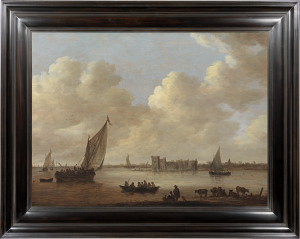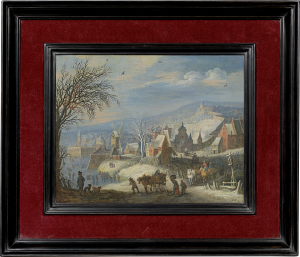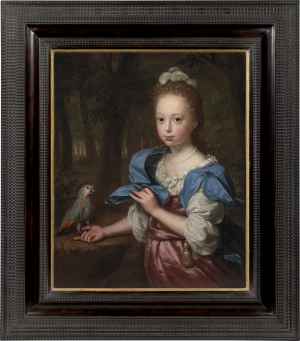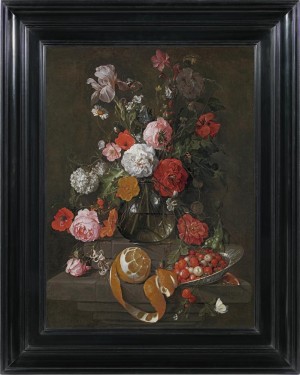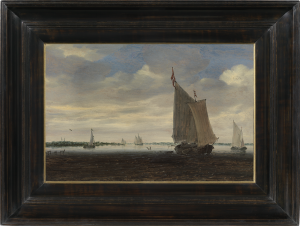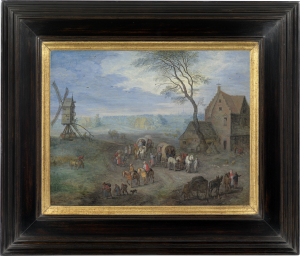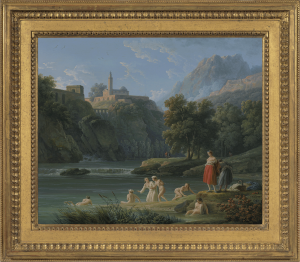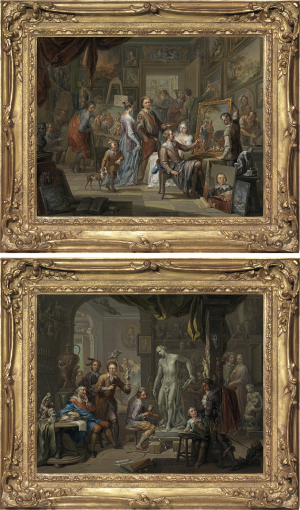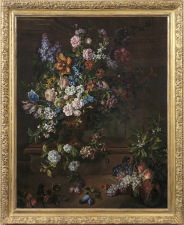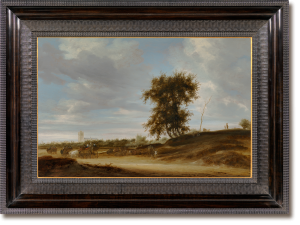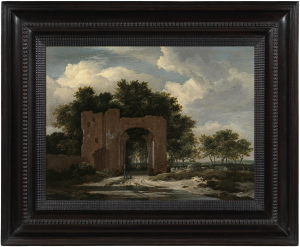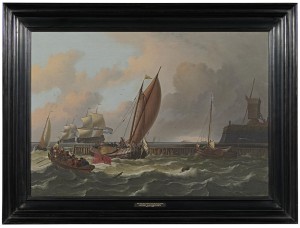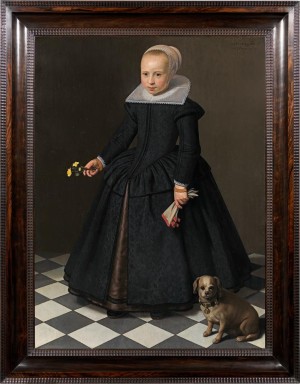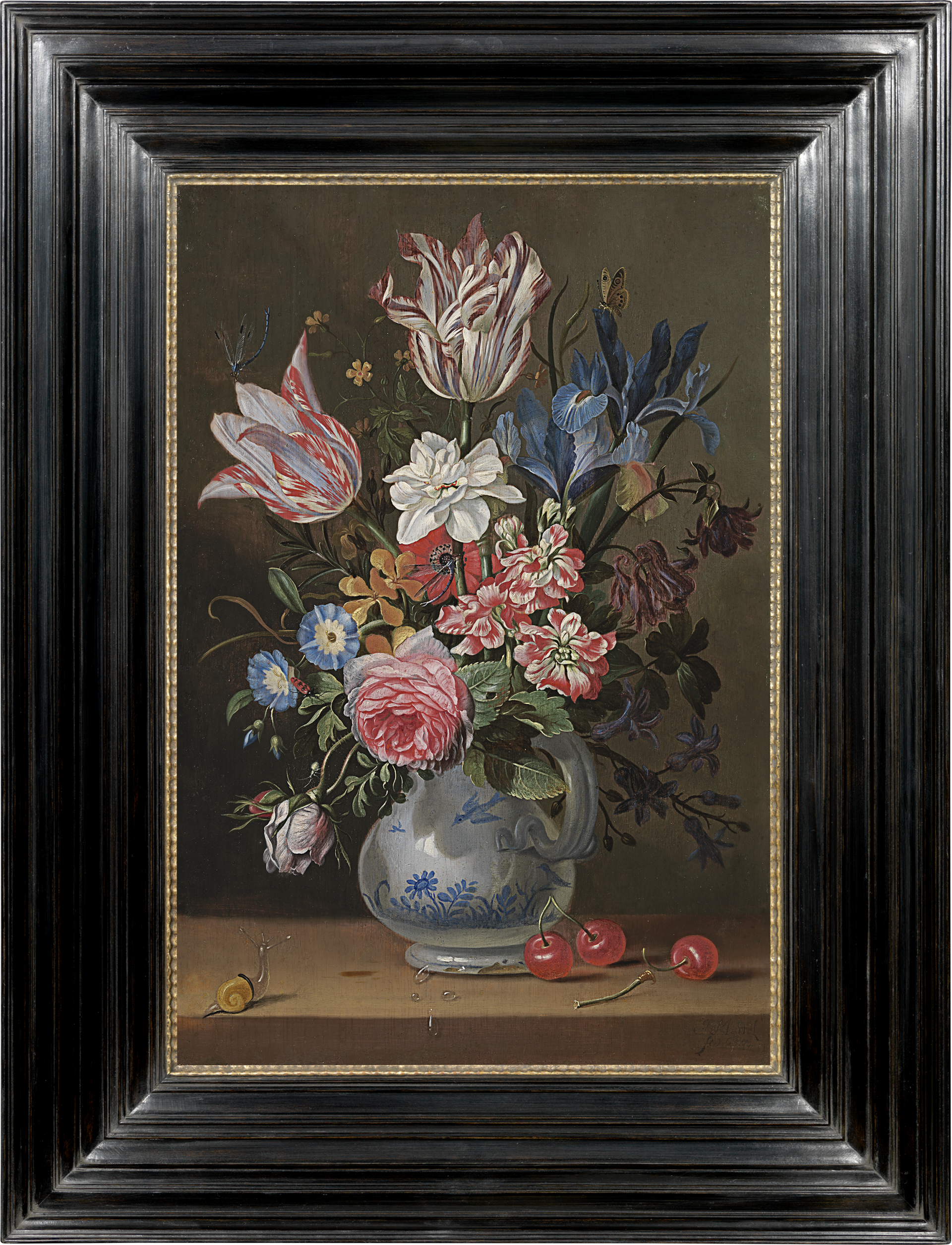Jacob Marrell
Still life of tulips,roses, irises, a narcissus, stocks and other flowers in a blue and white vase, with cherries and a snail on a ledge
Oil on panel: 16.9 x 11.5 (in) / 42.9 x 29.2 (cm)
Signed and dated lower right: J Marrel / fec 1657
This artwork is for sale.
Please contact us on: +44 (0)20 7493 3939.
Email us
JACOB MARREL
Frankenthal 1614 – 1681 Frankfurt-am-Main
Ref: CB 229
Still life of tulips, roses, irises, a narcissus, stocks and other flowers in a blue and white vase, with cherries and a snail on a ledge
Signed and dated lower right: J Marrel / fec 1657
Oil on panel: 16 7/8 x 11 ½ in / 42.9 x 29.2 cm
Frame size: 23 ¼ x 18 in / 59.1 x 45.7 cm
Jacob Marrel spent his career between western Germany and the Netherlands, forming a link between the Frankenthal school of still life painting and the Flemish tradition of Jan Davidsz. de Heem, in whose studio he served from 1636. In 1657, when this painting was made, he was living in Frankfurt-am-Main but making frequent trips to Utrecht, a town strongly associated with de Heem.
In bouquets such as this Marrel favoured bright, clear colours, with a balance of warm pinks, red and gold with blues and white. Tulips, as so often, crown the composition. He chooses rare and exquisitely marked blooms, described with a botanist’s precision. Tulips were traded in Frankfurt from early in the seventeenth century and they appear in florilegia in and around that city from 1611[1]. Marrel was caught up in the Dutch Tulip Mania of the 1630s, dealing in the bulbs and executing a number of watercolours for Tulip Books codifying the varieties, which were given flamboyant names such as Semper Augustus or Admirael Tromp[2]. In fact, no-one could predict which bulbs would ‘break’ into the glorious, coloured flames that were so prized. The effect was caused by a virus, which was not understood at the time. Marrel, like so many speculators, had his fingers burned when the tulip bubble collapsed in 1637.
Surrounding the tulips are other spring and early summer flowers: a glowing white double narcissus, an anemone (another favourite flower of Marrel), irises, morning glory, wallflowers, carnations and roses. Darker, more delicate flowers, such as the purple columbines, are placed at the back, with the intention of pushing the light-coloured, more sculptural flowers forwards. The flowers are placed in a blue and white earthenware jug, either German or Delft, made in emulation of the costly blue and white Chinese porcelain which the Dutch East India Company began to import into Europe at the beginning of the seventeenth century. Marrel’s jug is slightly chipped at the base, adding a delightful air of naturalism.
Marrel places a number of insects among his bouquet, a reminder of life in the gardens from which this bouquet has seemingly so lately been plucked[3]. A red beetle contrasts with the blue of the morning glory and another insect picks its way along the hairy stem of the rosebud. In the left foreground, a snail rears up in contemplation of the all-too-edible blooms. Its glistening body is superbly described and echoes the points of light on the drops of water on the ledge and the slick glaze of the jug. At the right are three sour cherries or morels, a play on Marrel’s name and thus a second signature.
JACOB MARREL
Frankenthal 1614 - 1681 Frankfurt-am-Main
Jacob Marrel was one of the greatest masters of the Utrecht and Frankenthal schools of still life painting, forming an important link between the Bosschaert dynasty and the Flemish tradition of Jan Davidsz. de Heem (1606-1683/4) and Daniel Seghers (1590-1661). He was also an accomplished draughtsman, engraver and art dealer.
Marrel was born in Frankenthal, south of Frankfurt, in 1614 and moved with his family to Frankfurt-am-Main in 1624, where he became a pupil of Georg Flegel (1566-1638) in 1627. From c.1630 to 1649 Marrel lived in Utrecht, where in 1636 he was apprenticed to and then a member of the studio of Jan Davidsz. de Heem. In 1641 Marrel married Catharina Elliot. After her death in 1649, he returned the following year to Frankfurt and in 1651 married Johanna Sibylla Heinius, widow of the famous engraver and publisher Matthäus Merian I (1593-1650). Among his pupils were his stepdaughter Maria Sibylla Merian (1647-1717), who became a renowned naturalist and scientific illustrator, and the flower painter Abraham Mignon (1640-1679). Marrel made frequent return trips to Utrecht until 1659, when he settled again in Utrecht, with shorter sojourns in Frankfurt. He died in Frankfurt in 1681.
Marrel’s earliest flower pieces date from 1630 and show the influence of Roelandt Savery (1576-1639) and Ambrosius Bosschaert II (1609-1645). Dated works are known from 1634 to 1681. Later he was influenced by Jan Davidsz. de Heem, sometimes imitating his work but signing J. Marellus fecit ab Heem. His oeuvre encompasses bouquets, flowers strewn on a table top, sumptuous still lifes, some with birds or Vanitas, and a single forest-floor piece. In the 1630s he was caught up in the so-called Tulip Mania, trading in the bulbs and producing exquisite watercolours for Tulip Books. Like so many, he was stung when the market crashed in 1637.
The work of Jacob Marrel is represented in the Rijksmuseum, Amsterdam; the Frans Hals Museum, Haarlem; the Metropolitan Museum of Art, New York; the Muzeum Narodowe, Warsaw; the Ashmolean Museum, Oxford; the Fitzwilliam Museum, Cambridge; Kronborg Castle, Copenhagen and the Staatliche Kunsthalle, Karlsruhe.
[1] Sam Segal and Klara Alen, Dutch and Flemish Flower Pieces, vol. I, Leiden 2020, p.289, note 61.
[2] Tulip Books by Marrel are in the collection of the Rijksprentenkabinet, Amsterdam and the Oak Spring Garden Foundation, Upperville, Virginia.
[3] As with most seventeenth century flowerpieces, the bouquet would never have existed in reality, but was cleverly assembled from drawn or painted studies kept in the studio and combined to form a convincing composition.

